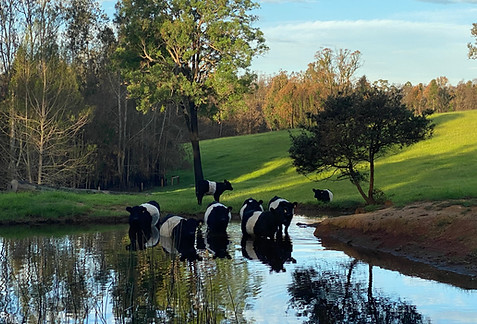
Some lowdown on our moos
Mogendoura Farm 220 acres with 2km river and creek frontage, specialising in breeding, raising and importantly finishing 100% grass fed Belted (Belties) Galloway cattle for local produce supply.
My love for ‘Belties’ started as a young child, nose pushed up against the glass or the car window, straining to catch a glimpse of them in the paddocks outside of Canberra.
We have now been specialising breeding Belted Galloways since the purchase of the farm 10 years ago. Starting with four cows, one to have our farm Bull, Hercules. Since then, we have purchased selectively cows or heifers from other breeders to ensure we have a great mix of bloodlines throughout the herd. So at any one time we will have at various ages 55-70 head. We are quite different to traditional farming; breeding all year round. Our bull Hercules will be rotated between the two herds. Calves are left with their mothers, weaning rings are used (if necessary) so family groups can stay together. Also whether you are a ‘permanent’ or ‘temporary’ resident on the farm, everyone gets a name. Following the Galloways Australia Herd book everyone born in a certain year receives a name starting with the relevant letter of the alphabet for that year. Largely they are left alone, to enjoy roaming the farm. Focused on rotational grazing we can easily just call the herds from paddock to paddock, no dogs, horses, or trailbikes necessary!


Pasture improvement plays a major role with how we raise our Belted Galloways. Lets face it, if your only feeding grass, then you need a lot of it! Ideally a variety of grasses. All manner of native grasses, especially Microlena (weeping grass) which is naturally high in protein and low in sugar to planting rye and clover (nitrogen soil conditioner). We are also very conscious not to ‘overstock’ and place unnecessary stress on our pastures. Over the years we have fertilised and planted tree banks, and fenced off fragile environmental areas from the Belties. I have spent years relocating ‘Dung Beetle’ to all areas around the farm. Dung beetles are fabulous critters, taking the manure down deep into the soil, not just fertilising but aerating. We also work with a local lawn-mowing business, Mow Me Lawns. He needs to get rid of his grass clippings and I need organic matter. We have now perfected the art of spreading the clippings over the pasture and the difference is very noticeable. Unfortunately the 2020 fires nearly un-did the years of hard work but with the recent rains we hope to be back in a better place soon.
Our grass-rearing trinity
Ethically farming livestock respects the animal and the land. Our beef is 100% grass-fed with no added hormones or preservatives. Born on grass, raised on grass and finished on grass. We are fortunate to have an abattoir only 15 minutes away, greatly reducing the stress to our animals. They are taken the morning of processing to eliminate the ‘waiting period’.This is of course the hard part of the job, so making it stress-free as possible, is paramount.
‘Beltie’ coats are unusual in a number of ways. Due to the harsh environment in which Galloways evolved, their coat has high insulation properties. This coat modifies the cattle’s fat distribution: it requires less external fat for insulation, allowing them to deposit much of their fat as intra-muscular, creating marbling. Marbled fat has a healthy composition of fatty acids and provides meat with flavour and juiciness.
Galloway meat is high in protein, minerals and antioxidants, while also low in cholesterol and saturated fat, with an exceptional Omega 6:3 ratio. Galloways do not need to be fed any grain to naturally achieve high levels of marbling and are entirely raised on a diet purely of grass or hay. Definitely, no corn syrup or beef pellets are used to finish our cattle.
Some facts on the benefits of 100% grass-raised beef.
Do your homework as anyone can say grass-fed beef as long as the animal has spent 51% of its life on pasture/grass. However, it can then be ‘finished’ on anything. Ruminants evolved to eat grass and little else. This is a beautifully simple way to produce meat, and when done well this method of production has far-reaching benefits. It has not only been shown to produce healthier meat from a happier animal, but it benefits the natural environment too — building soil life, organic matter, and increasing whole-farm biodiversity.
"Science shows that meat from ruminants fed a pasture-only diet is healthier, with lowerlevels of saturated fats, a healthier balance of omega 3 to 6 and higher levels of vitamins A, E, and Conjugated Linoleic Acid (CLA) known for its cancer-fighting properties."

Currently, you'd be hard pushed to find 100% grass-fed products in the supermarkets, so producers tend to use direct selling. Labelling is confusing and as consumers, we are often tricked with false promises. If livestock spends just 51% of its time eating grass then it can be sold as "grass-fed". The only guarantee that you are buying 100% grass-fed products is to look for the certified "Pasture for Life" mark, provided by the Pasture-Fed Livestock Association (PFLA).
There is a huge difference between meat that is exclusively grass-fed, and that which is finished on grain, explains PFLA director Sara Gregson: "Once animals come inside and are fed grain, all that goodness disappears in a matter of weeks. Most farmers that say their animals are grass-fed are actually finished on grain, so all those benefits are gone. Ruminants were never meant to eat grain. They actually get ill from it; they get a disease called rumen acidosis."
At Mogendoura Farm our Beltie Galloways live a happy life adhering to a strict100% grass-fed trinity — born, raised and finished on grass.
